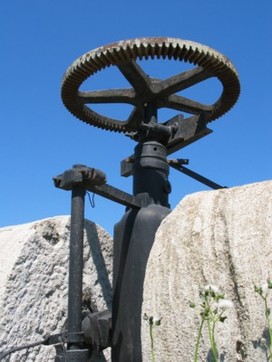Olive Oil Extraction Processes
The most important difference in olive oil extraction is that it can be done mechanically, without using chemicals as with most seed oils.
Traditional Olive Press
2-Phase System Decanters
|
2-Phase system decanters were introduced in the early 1990's. They function under the same principle as 3-Phase decanters except that the solid and fruit-water exit together. No water needs to be added to the 2-Phase system.
Experience with the two olive oil extraction processes shows that the 2-Phase system has some advantages, i.e., better retention of polyphenols because no water is added and less loss of oil if the system is operated properly. One problem with the 2-Phase system is a greater potential to lose oil when the olives are low in moisture because there is a thinner interface between the two phases during centrifugation. Another difficulty is less visualevidence of what is happening with waste characteristics because the solid and vegetation water phases are mixed. Water can be added to the paste just prior to entering the 2-Phase decanter if the moisture content of the olives falls below 42%. Talc (a water absorbing neutral compound) can beadded to the paste early in the season, if the olives have an excessive moisture content, to help extract a greater quantity of oil with no negative effect on quality. The 2-phase system produces the greatest weight of solid waste because it has the highest moisture content. It also produces the least amount of wastewater with the lowest Biological Oxygen Demand (BOD). The polyphenol content of the oil is lowest in the 3-phase system because of the addition of water. When very clean oil (containing no water) is obtained from a 2-Phase system, it means that there is a loss of oil to the waste solids because of the limited separation area within the decanter. The solution is to extract oil with some water in it and immediately run it through a vertical centrifuge to clean the oil further. Vertical Centrifuge Vertical centrifuges spin at two times the velocity of a decanter and provides four times the separation force for the solid, water, and oil phases. They provide an additional separation of the three phases to further remove solid particles and water from the oil. Fresh warm water is added to "clean" the oil, creating a greater interface area between the phases. Many processors use two centrifuges, one for the "wet" oil from the decanter and a second one to separate the oil from the wastewater of the first centrifuge. Added water is only 2-4°F warmer than the water/oil mixture to be separated. Reprinted with permission from and written by Paul Vossen, Fruit, Vegetable & Marketing Advisor, Sonoma County University of California Cooperative Extension. |

